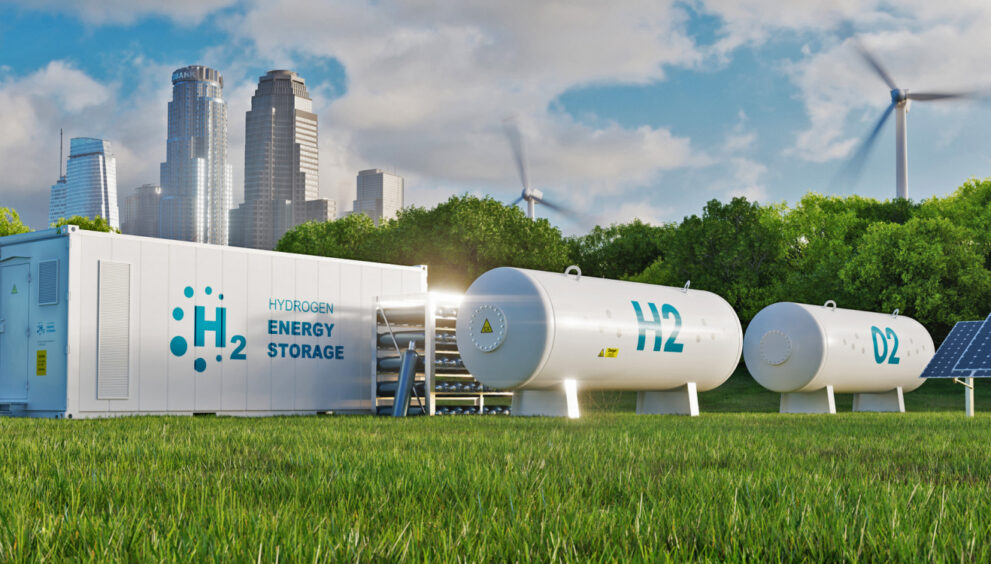Green Energy For A Better Tomorrow: The Hydrogen Promise

Organizations worldwide are discovering the transformative power of green hydrogen as an energy source in shaping a sustainable future.
Traditional fossil fuels such as crude oil and coal have inflicted significant damage on our planet, contributing to climate change, air pollution, and energy insecurity. To address these pressing challenges, transitioning to clean and renewable energy sources is crucial. According to the reputable EY report titled “How Green Hydrogen Can Help India Achieve Its Net Zero Ambition,” green hydrogen emerges as a key driver in accelerating the clean energy revolution. The significance of green hydrogen in enabling a sustainable future is emphasized by compelling evidence and insights derived from credible reports, as well as pioneering initiatives aimed at advancing this revolutionary technology.
The reason why hydrogen holds a strong promise is simple. When we use hydrogen as a fuel and burn it – it produces high energy and emits steam or water. No harmful emissions. Several esteemed organizations have emphasised the pivotal role of green hydrogen in decarbonizing critical sectors like transportation, industry, and power generation. Green hydrogen, produced through electrolysis using renewable energy sources, offers a clear pathway to significantly reduce carbon emissions. It not only addresses the intermittency challenge of renewable energy by enabling energy storage and supply but also promotes grid stability and facilitates the higher integration of renewables. Moreover, green hydrogen serves as a clean and sustainable energy source for hard-to-abate sectors like power, cement, and metals – playing a crucial role in their decarbonization efforts.
India’s Green Hydrogen Policy plays a crucial role in facilitating the transition to a sustainable energy future. With most large economies, including India, committing to net zero targets, the adoption of green hydrogen and green ammonia becomes imperative, particularly in hard-to-abate sectors. The Government of India has carefully considered various policy measures to support this transition from fossil fuel-based feedstocks to renewable energy-based green hydrogen and green ammonia. The policy outlines key provisions, including the definition of green hydrogen and green ammonia as products produced through electrolysis of water using renewable energy sources, including banked renewable energy and biomass.
With projections indicating a 5-7 times surge in green hydrogen demand over the next three decades, the establishment of efficient and cost-effective production methods becomes imperative. To augment this journey, organizations worldwide are making conscious efforts to improve technologies and their applications which is evident by their commitment to spearheading this revolutionary transformation. For example – the industry is spearheading the development of a catalyst-coated membrane (CCM) that when used in the electrolysers, significantly enhances electrolyser performance, thereby meaningfully reducing the cost of green hydrogen production. Many companies in the industry have embraced the technology and products that instrument and automate electrolyser usage for ease of use and hassle-free operation.
However, achieving our ambitious goals necessitates collaborative efforts and government intervention. It is imperative to foster innovation and implement solutions that effectively reduce the cost of green hydrogen. Establishing mandates, incentives, and a conducive policy environment are key factors in promoting widespread adoption. Furthermore, investment in renewable energy capacity, skill development, and public-private partnerships play a crucial role in realising India’s green hydrogen vision.
Companies today are fully committed to driving the green hydrogen revolution forward. Leveraging our expertise and technological advancements, we find ourselves at the forefront of this transformative journey. By combining our innovative catalyst-coated membrane technology with renewable energy sources, we are paving the way for cost-effective and efficient green hydrogen production.
The benefits of embracing green hydrogen are immense. Not only does it help mitigate the environmental challenges posed by traditional fossil fuels, but it also empowers us to construct a sustainable future for generations to come. Green hydrogen offers a clean and sustainable energy alternative, reducing carbon emissions and improving air quality. Moreover, it promotes energy security and reduces dependence on fossil fuel imports, enhancing our energy resilience.
One more related topic deserves attention – The blue hydrogen. The blue hydrogen is produced using steam and natural gas or methane and capturing the carbon dioxide thus produced in the process, to either sequester it underground or use it for other purposes. This is one area that needs promotion to make a bridge between the current reality and the future green hydrogen-based industry. Embracing it will further accelerate the hydrogen ecosystem.
In India, with its advantage in low-cost renewable energy, there is a strong aspiration to become a global hub for green hydrogen and spearhead the clean energy transition. Projections indicate that the green hydrogen market in India could reach a remarkable $8 billion by 2030 and an astounding $340 billion by 2050. By harnessing our indigenous manufacturing capabilities, we have the potential to tap into this colossal market and emerge as a powerhouse of zero-carbon export products, including green steel and green ammonia. The possibilities are simply exciting.
Dedicated commitment to innovation and research fosters the development of cutting-edge solutions that propel green hydrogen adoption. Together with industry leaders, governments, and stakeholders, we can create an ecosystem that fosters the growth of hydrogen technologies and accelerates the transition to a sustainable energy future.
The hydrogen revolution is not a mere abstract concept; it represents a tangible promise that can reshape our future. By playing a crucial role in this transformative journey, the convergence of a collective vision of sustainability, collaborative partnerships, and technological advancements are instrumental in harnessing the immense possibilities of green hydrogen, ultimately leading us towards a world that is free from carbon emissions.
 About the Author: Mr Ashish M Gaikwad brings over 32 years of experience in industrial automation & controls, industrial software applications, and process technologies. He is currently VP-GM for Honeywell UOP India. Ashish began his career as a software engineer. Through his journey, he has served at Honeywell in multiple roles of increasing responsibility, in several geographies including India, Southeast Asia, Asia Pacific, and the USA.
About the Author: Mr Ashish M Gaikwad brings over 32 years of experience in industrial automation & controls, industrial software applications, and process technologies. He is currently VP-GM for Honeywell UOP India. Ashish began his career as a software engineer. Through his journey, he has served at Honeywell in multiple roles of increasing responsibility, in several geographies including India, Southeast Asia, Asia Pacific, and the USA.
































































































































































































































































































































































































































































































































































































































































































































































































































































































































































































































































































































































